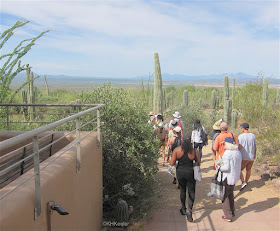I recently attended the Botanical Society of America annual meeting, this year in Tucson, Arizona. Of course we botanists, gathered from not only across America but from around the world, spilled out of the conference center to see the surrounding desert, botanical gardens, plant breeding centers, and more.
The daily high temperatures were over 100º F and some nights the low was above 80º F. I expected it to be like being in an oven, and it was. But I also expected the desert to be brown, like the photo below of the desert in Baja California in April
 |
| Dry hillside, Baja California (April) |
 |
| Tucson hillside, July |
Not only that, there were leaves on plants that are normally leafless.
It was hot, but it was fascinating.
A pea-family (Fabaceae) shrub with bright yellow flowers, probably desert senna, Senna covesii.
The small shrubby plant with scarlet flowers is ratany, genus Krameria, although I do not know which species. Ratanies are the only genus in a plant family of 18 species, the Krameriaceae, native from Arizona and Texas to southern Chile. See also In Defense of Plant's story about them link.
 |
| ratany, Krameria |
 |
| ocotillo, Fouquieria splendens |
The green parts of cacti are modified stems, not leaves, which adapts them to dry conditions. A very few cacti ever have leaves, and those only briefly. Here is a cholla (genus Cylindropuntia, cactus family Cactaceae) and if you look carefully at the branches, there are tubular green leaves along the stem. That inch or so of rain was enough for this plant to grow leaves. Compared to stems, leaves photosynthesize better, bringing more energy to the plant, but they lose more water, too. The cholla is growing while the growing is good.
 |
| cholla with leaves |
 |
| closer view of leaves |
Here is a look down the hill. Lots of green leaves on the shrubs.
So don't be fooled by Arizona's high temperatures. The plants are active in July and August. Lots to see. Leaves, flowers, and pollinators, day and night. Most bees and butterflies flew off before I could take a photo. Although I didn't get the focus right, below are two flies visiting thee flowers of rough menodora, Menodora scabra, olive family Oleaceae.
 |
| rough menodora, Menodora scabra, and flower-visiting flies |
It is a very tough climate and yet there are diverse native plants and animals.
Comments and corrections welcome.




No comments:
Post a Comment